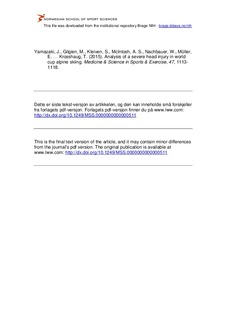Analysis of a severe head injury in world cup alpine skiing
Yamazaki, Junya; Gilgien, Matthias; Kleiven, Svein; McIntosh, Andrew S.; Nachbauer, Werner; Müller, Erich; Bere, Tone Tufte; Bahr, Roald; Krosshaug, Tron
Journal article, Peer reviewed
Permanent lenke
http://hdl.handle.net/11250/2394604Utgivelsesdato
2015-06Metadata
Vis full innførselSamlinger
- Artikler / Articles [2119]
Originalversjon
Medicine & Science in Sports & Exercise. 2015, 47, 1113-1118 10.1249/MSS.0000000000000511Sammendrag
Traumatic brain injury (TBI) is the leading cause of death in alpine skiing. It has been found that helmet use can reduce the incidence of head injuries between 15% and 60%. However, knowledge on optimal helmet performance criteria in World Cup alpine skiing is currently limited owing to the lack of biomechanical data from real crash situations.
Purpose: This study aimed to estimate impact velocities in a severe TBI case in World Cup alpine skiing.
Methods: Video sequences from a TBI case in World Cup alpine skiing were analyzed using a model-based image matching technique. Video sequences from four camera views were obtained in full high-definition (1080p) format. A three-dimensional model of the course was built based on accurate measurements of piste landmarks and matched to the background video footage using the animation software Poser 4. A trunk–neck–head model was used for tracking the skier’s trajectory.
Results: Immediately before head impact, the downward velocity component was estimated to be 8 m·s-1. After impact, the upward velocity was 3 m·s-1, whereas the velocity parallel to the slope surface was reduced from 33 m·s-1 to 22 m·s-1. The frontal plane angular velocity of the head changed from 80 rad·s-1 left tilt immediately before impact to 20 rad·s-1 right tilt immediately after impact.
Conclusions: A unique combination of high-definition video footage and accurate measurements of landmarks in the slope made possible a high-quality analysis of head impact velocity in a severe TBI case. The estimates can provide crucial information on how to prevent TBI through helmet performance criteria and design
Beskrivelse
Dette er siste tekst-versjon av artikkelen, og den kan inneholde små forskjeller
fra forlagets pdf-versjon. Forlagets pdf-versjon finner du på www.lww.com:
http://dx.doi.org/10.1249/MSS.0000000000000511 / This is the final text version of the article, and it may contain minor differences
from the journal's pdf version. The original publication is available at
www.lww.com: http://dx.doi.org/10.1249/MSS.0000000000000511
